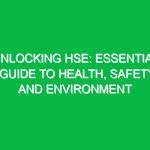Introduction
In the realm of Health, Safety, and Environment (HSE), understanding the concept of Local Exhaust Ventilation (LEV) is crucial for maintaining a safe and healthy workplace. But what is LEV? LEV systems are engineering controls designed to capture and remove airborne contaminants at the source before they can enter the breathing zone of workers. This article delves deep into the significance of LEV within the HSE context, exploring its components, benefits, regulatory requirements, and Best Practices that organizations must adopt to enhance Workplace Safety.
What is LEV?
Local Exhaust Ventilation (LEV) refers to a system that operates by extracting harmful dust, fumes, vapors, or gases from the air in an industrial or commercial environment. These systems are typically installed in areas where hazardous materials are used, processed, or generated, such as laboratories, factories, and construction sites. The primary goal of LEV is to minimize employee exposure to airborne contaminants, thereby reducing the risk of health issues and improving overall Workplace Safety.
Key Components of LEV Systems
An effective LEV system comprises several essential components that work together to provide optimal air quality:
- Capture Hood: The part of the system that captures airborne contaminants at the source. Its design and placement are crucial for effective Operation.
- Ducting: The network of pipes that transport the contaminated air from the capture hood to the filtration or exhaust point.
- Filtration: This component removes harmful particles, gases, or vapors from the air before it is released back into the environment.
- Exhaust Fan: The fan helps to create the necessary airflow within the system, ensuring that contaminants are efficiently removed from the workspace.
- Make-Up Air: Fresh air that replaces the exhausted air, helping to maintain proper air pressure and ventilation within the space.
Importance of LEV in Health and Safety
The use of LEV systems in workplaces is not just a regulatory requirement; it is a fundamental aspect of promoting health and Safety. The Benefits of implementing LEV systems are manifold:
- Reduction of Health Risks: By removing harmful contaminants from the air, LEV systems significantly reduce the risk of respiratory diseases, skin irritation, and other health issues associated with prolonged exposure to hazardous substances.
- Improved Work Environment: Cleaner air leads to a more comfortable and productive work environment, thereby enhancing employee morale and efficiency.
- Compliance with Regulations: Many countries have stringent regulations regarding workplace air quality. Implementing LEV systems helps organizations comply with these legal requirements, thereby avoiding fines and legal repercussions.
- Cost-Effectiveness: While the initial investment in LEV systems can be substantial, the long-term savings from reduced health-related costs and increased productivity can outweigh these expenses.
Potential Hazards and Risks
Despite their benefits, LEV systems must be properly designed, installed, and maintained to be effective. If not, they can pose potential Hazards:
- System Failure: A malfunctioning LEV system can lead to increased airborne contaminants, posing serious health risks to workers.
- Improper Design: An inadequately designed system may not capture contaminants effectively, leading to hazardous exposure.
- Maintenance Issues: Failure to regularly maintain the system can result in reduced efficiency and increased operational costs.
Best Practices for Implementing LEV Systems
To ensure that LEV systems are effective, organizations should adopt a series of Best Practices:
1. Conduct a Thorough Risk Assessment
Before installing an LEV system, organizations must conduct a comprehensive risk assessment. This process involves identifying potential sources of contamination, evaluating the level of risk associated with each source, and determining the appropriate type of LEV system needed.
2. Engage Qualified Professionals
It is essential to work with qualified professionals who have expertise in designing and implementing LEV systems. These experts can ensure that the system is tailored to the specific needs of the workplace.
3. Regular Maintenance and Testing
Routine maintenance and testing of LEV systems are critical for ensuring their effectiveness. Organizations should establish a maintenance schedule that includes regular inspections, cleaning, and performance testing to identify any issues before they become significant problems.
4. Employee Training and Awareness
Employees should be educated about the importance of LEV systems and how they function. Training programs should include information on how to use the systems properly and recognize potential issues.
5. Monitor Air Quality
Implementing a regular air quality monitoring program can help organizations assess the effectiveness of their LEV systems. This data can inform any necessary adjustments or improvements to the system.
Regulations and Standards Governing LEV
Several regulations govern the implementation and operation of LEV systems, which vary by country and industry. In the United States, for instance, the Occupational Safety and Health Administration (OSHA) sets forth standards that require employers to control exposure to airborne contaminants. In the United Kingdom, the Control of Substances Hazardous to Health (COSHH) regulations mandates that employers assess risks and implement appropriate Control Measures, including LEV systems.
These regulations often require:
- Regular inspection and maintenance of LEV systems to ensure their efficacy.
- Training for employees on the proper use of LEV systems and understanding their roles in maintaining safety.
- Documentation of risk assessments and maintenance records to demonstrate compliance with health and safety standards.
Conclusion
In summary, Local Exhaust Ventilation (LEV) systems play a pivotal role in ensuring health, safety, and environmental Sustainability in the workplace. By understanding what is LEV and its significance, organizations can take proactive steps to protect their employees from airborne contaminants. The benefits of reducing health risks, improving work environments, and ensuring compliance with regulations cannot be overstated.
As industries continue to evolve, so do the challenges related to Workplace Safety. Therefore, it is imperative for organizations to remain vigilant and commit to best practices for implementing and maintaining LEV systems. By doing so, they not only safeguard their workforce but also contribute to a healthier, more productive workplace for everyone.
In the ever-changing landscape of health and safety, it is essential that we continuously evaluate and improve our systems. LEV is not just a compliance measure; it is a commitment to fostering a culture of safety and well-being.


